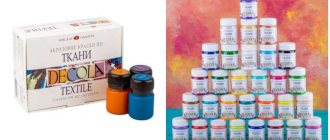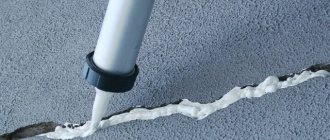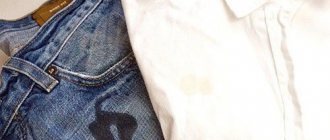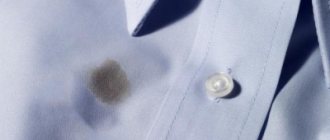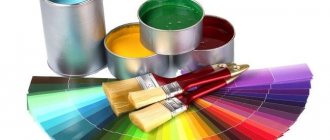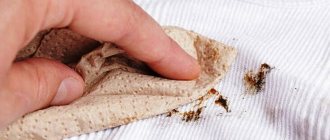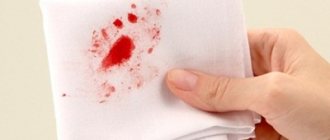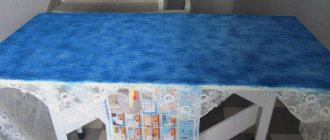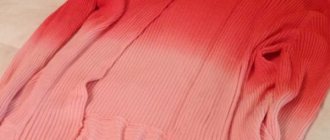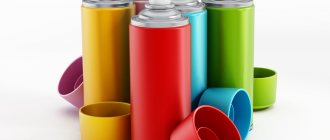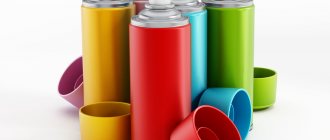Probably, each of us has encountered a situation where our favorite black trousers have lost their former brightness of color. Of course, you can throw them away and buy new ones, but when it’s a pity to throw away your favorite model of trousers, you can revive it and try to restore its original color using special dyes for clothes.
Dry cleaners can handle this task efficiently and quickly, but not all areas provide such services and the cost is probably not small. Therefore, you can try to dye black trousers at home. It's quite easy and simple, you just need to choose the right paint and follow a few simple rules.
The trousers have lost their color and wear is visible
What fabric can be re-dyed?
First of all, I would like to clarify which fabric can be re-dyed and what nuances should be taken into account before choosing a dye and the process itself.
- Before purchasing fabric dye, look at the clothing label on the label. This will help you decide on the most optimal paint for color restoration and painting method. If you don’t know the nature of the material, buy universal dyes for any type of fabric.
- The most rewarding material in terms of re-dying is natural fabrics: linen, cotton (cotton), silk, wool. Mixed material containing 30-40 percent natural components also works well. As for synthetic clothing, its restoration should be entrusted to dry cleaning, because... Often, when dyeing it at home, the paint is quickly washed off during washing. However, fortunately, today there is a special fabric paint that is suitable for 100% synthetics. It will be discussed below.
- We also note that white fabric can be dyed in any color: from light to black tones. As for dark clothing, it is possible to restore the original shade with the appropriate paint tone. If you need to radically repaint, such clothes must first be bleached, for example, with a white solution.
- A certain fabric composition differs in density and fiber characteristics, and this should be taken into account when restoring color. So, thick cotton or denim is the most unpretentious fabric. Therefore, when working with it, you can choose any painting method.
- Wool and silk fabrics do not react well to the boiling process, so it is better to dye them in a washing machine on a gentle cycle. In this case, paints are used that are activated at temperatures less than 95 degrees, such as vat paints.
Fabrics made from natural fibers are best dyeable.
Choosing paint for dyeing clothes
We live in an age of abundance. The chemical industry offers such a rich assortment that it can be difficult to decide what paint to paint clothes with. It is simply not possible to define all types of dyes in one article. Therefore, we will limit ourselves to a list and a brief description of the main types of things used to paint things.
- Aniline - recommended only for dyeing products made from natural fibers.
- Oil ones are the most difficult to use, but with guaranteed and long-term results.
- Acrylic - can be used not only for cotton, but also for silk fabrics.
- Water-glycerin - used to obtain radical dark shades (for example, black or dark blue).
Types of fabric paints
There is a huge selection of fabric paints. This is due to the great demand for unique color schemes in the design of clothing, fabric interior items and the enormous popularity of this type of applied art such as painting on fabric. Therefore, to answer the question of what can be used to dye fabric, let’s look at the types of dyes, both in terms of release form and composition.
Forms of release and color fastness
Fabric paints sold in specialized stores, depending on the form of release, are divided into:
- Powders
- Pastes
- Liquids
- Special markers (felt-tip pen) and outlines
- Sprays
If you plan to dye the fabric completely, then it is more convenient and faster to use powder, paste or liquid. Markers are primarily intended for painting on fabric. Sprays are easy to use because... they do not need to be diluted before dyeing, they are simply applied to the clothes. They are also optimal for multi-color painting.
Depending on the degree of color fastness, dyes are either washable or indelible. Washable ones are great for temporarily transforming clothes and are washed out in 1-3 washes. As a rule, these are natural dyes. Leave-in formulations are relevant for one-time color renewal. They are lightfast and waterproof.
Various options for release forms of fabric dyes
Pros and cons of acrylic paints
Colors based on polyacrylates have found the widest use among needlewomen. Sold in jars, tubes, cylinders, they come in matte, glossy, and with mother-of-pearl.
Advantages of paints:
- quick drying;
- dilution with plain water;
- easy application;
- the ability to mix shades;
- low price;
- economical in consumption;
- brightness, color fastness;
- no need to fix the drawing;
- hypoallergenic, pleasant smell.
The work does not require any special skills; anyone can apply a stencil and make a drawing. But the disadvantages of paints also need to be taken into account:
- The shelf life of the colors is short; after their expiration, the properties of the products deteriorate;
- the pigment must be applied carefully - the substance spreads over the fabric;
- After application, a dense, non-stretchable area is formed - the elasticity of the material is lost.
Types of pigments by composition
Depending on the composition, there are natural dyes (tea, coffee, etc.) and synthetic ones sold in stores. Ready-made materials are easy to use and include the following types of paints:
- Acrylic
- Aniline
- Stamp
- Plastisol
- VAT
This article discusses ready-made fabric dyes that are sold in stores. We will discuss dyeing things with natural substances such as tea, coffee, and beets in another material.
To choose the optimal composition for dyeing fabric, we will dwell in more detail on each type of dye.
Pants before and after dyeing
Acrylic paints
One of the most popular materials for fabrics is acrylic paints. It is distinguished by a huge selection of assortments. There is acrylic with mother-of-pearl, shiny, silver, luminous, etc. This is due to the inertness of the acrylic paint base, due to which manufacturers include various additional components in it to give specific effects.
Required tools for application
The set of materials and tools will depend on the chosen dyeing technique. Here is a sample list of required accessories:
- the dye itself;
- pencil for contouring;
- brushes of different thicknesses;
- clean cloth;
- palette;
- frames, hoops;
- stencils;
- cotton swabs, disks;
- paint thinner (or water).
Dye for synthetic fabric
Most common dyes are not suitable for synthetic fabrics. Fortunately, there is an answer to the question: “How to paint synthetics?”
Jacquard iDye Poly is an American dye for 100% synthetic fabrics such as polyester, nylon, etc. This is an innovative product for dyeing artificial fabric at home.
The use of such a dye is comparable to the manual dyeing method, which will be discussed below.
Jacquard idye poly dyes for synthetic fabrics are available in the form of soluble sachets. You just need to throw it into the water without opening it, bring it to a boil and place the item. Cook for 30 - 60 minutes, stirring.
The contents of the bag are enough for 1-1.5 kg of dry laundry.
Dyeing clothes black
The technology for dyeing fabric black is practically no different from other shades.
- So, let's prepare the coloring composition. Mix warm water with your chosen dye. The dosage is determined in accordance with the manufacturer's instructions.
- Immerse the thoroughly washed and dried item in the solution so that it completely covers the fabric.
- Over the course of half an hour, turn the product over several times, trying to lay it out as evenly as possible, without creases or folds.
- Once the fabric has acquired an intense black color, proceed to rinsing. To do this, pour vinegar into clean cold water at the rate of 2 tablespoons per 5 liters of water. Rinse thoroughly and hang to dry.
- If a product made of wool or silk fabric is dyed, it is better to add 25% vinegar essence to the rinsing water rather than vinegar.
Attention! You should not paint several products at once - only one at a time. Otherwise, there is a high probability of some areas not being painted.
Fabric dyeing.
If you plan to dye clothes yourself at home, you can choose the manual method of dyeing by boiling or in a washing machine. It all depends on the type of dye and the manufacturer’s instructions.
As for the process of preparing textile material for dyeing, it includes the following:
- It is necessary to wash clothes and remove accessories. Rinse the woolen item in a weak solution of ammonia (2 tablespoons of ammonia per 12 liters of water).
- It is worth weighing things to accurately calculate the proportions of the coloring liquid.
The remaining stages of preparation and procedure depend on the staining method. The easiest way to restore color is in the washing machine.
Hand dyeing fabric.
How to dye fabric with regular aniline or other dye at home? Of course, first of all you should follow the instructions on the package. If for some reason it is not there, you can use the tips below.
- When painting using the boiling method, it is better to purchase or find clean aluminum utensils among your household equipment. The size of the container should be at least 1.5 times larger than the volume of clothing for uniformity and ease of work.
- It is advisable to prepare “soft” water, such as rain, melt or bottled water. If you only have tap water, then you should add soda in a ratio of 1 tbsp. l for 10 - 12 l. water for softening.
- The dye is dissolved in water in the proportion indicated on the package. The volume of the solution depends on the weight of the clothing. It is different for different paints, so it is important to take this nuance into account when working with a specific pigment.
- The clothes are placed in the solution and brought to a boil over low heat, stirring constantly. The fabric dyeing time is 20 minutes. The longer the process, the richer the color.
- When working with aniline dyes, at the end of dyeing add 2-5 tbsp to the solution. spoons of salt to fix the color. If wool is dyed, then add a little more vinegar, with cotton - soda (1-2 tablespoons).
- Remove the container from the heat and allow the contents to cool.
- It is recommended to dry clothes at room temperature in the shade
- Finally, the remaining paint is washed off from the clothes by rinsing until the water is completely transparent and clean.
It is recommended to wash dyed clothes separately from other items for the first time, as they may fade a little. After 3-4 washing cycles, natural fabrics with restored color can be washed together with other items.
Please note that dyeing fabrics by boiling is a rather aggressive method. Therefore, it is preferable to dye wool, silk and other delicate materials in the washing machine.
You can clearly see the process of dyeing clothes using the boiling method at home in the video below.
Video: how to dye jeans at home
Dyeing in the washing machine
Let's look at the procedure using the example of the well-known Simplicol paint. This is a German-made composition. Simplicol provides the buyer with a huge selection of colors: blue, gray, black, khaki, etc.
The paint can be used to paint natural fabrics and those mixed with a synthetic content of no more than 50%. The color indicated on the package corresponds to the dyeing of white 100% cotton fabric. If the fabric is colored, it is recommended to pre-bleach it. The more synthetics in the composition, the less saturated the color will be after application to the fabric.
Simplicol is a leave-in composition and guarantees color fastness.
The Simplicol line includes pigments suitable for painting fabrics in the Batik style and for dyeing clothes manually in a basin (Simplicol Expert paint series).
If you need to dye, for example, a denim jacket, then to restore the color with Simplicol in the washing machine you need to perform a number of simple steps:
- Turn the jacket inside out and put it in the washing machine.
- Cut off the edge of the paint bag with scissors and place it on top of the jacket (no need to pour out the dye).
- Set the temperature recommended by the manufacturer for a specific type of clothing.
- Select the normal wash cycle and complete the program with all standard cycles.
- To fix the paint, add washing powder or gel without removing the clothes from the drum.
- Carry out a second wash with all rinse and spin cycles at the permissible temperature.
This method of coloring is as convenient and simple as possible. You can visually familiarize yourself with the process of color restoration in a washing machine in the form below.
Video: how to dye clothes in the washing machine
In addition to Simplicol, among the well-known brands with good reviews is RIT paint. It has a varied palette of colors - about 20 shades and is suitable for dyeing in an automatic washing machine. The dyeing process is similar to that described above. Detailed instructions are also indicated on the packaging.
Dyeing clothes using mordant
Of course, you first need to thoroughly wash contaminated clothes so that no stains remain on them.
- Next, boil the item to be painted for one to two hours with water and mordant (a chemical preparation that fixes the paint in the fiber structure). The optimal amount is one teaspoon of mordant per liter of water. Boil over low heat to allow the color to penetrate deeper into the fibers.
- Then let the fabric simmer until it reaches the desired color. Stir again and again - this is necessary for a uniform result.
- Finally, to remove excess color, rinse your freshly dyed clothes in the washing machine.
Useful tips for quality painting:
- If you're painting for the first time, try painting something you don't mind ruining first. If the painting is successful, you can start changing the color of your favorite trousers.
- Leave the items in the shade to dry after painting. The sun's rays cause the color to fade quickly.
- Reducing the proportion of dye may result in a lighter shade.
- You should wash dyed black trousers separately from other items the first few times. During the first washes, the dye may come off the trousers intensively and ruin other things.
- Before dyeing, pay attention to the markings on the clothing tag. You need to know whether the item is suitable for dyeing.
Hand dyeing trousers
Before starting the process, protect your hand skin from chemical components. Be sure to wear gloves. Next, proceed in such a way that the black dye for clothes gives a high-quality result:
- If painting takes place in the bathroom, cover the entire bathtub or the area of the bathtub where the dye container will be placed with film in advance. This way you will protect the bathtub from paint.
- Pour water into a basin according to the proportion and add paint in parts. Stir the mixture well while pouring.
- Dip your trousers or dress into the contents of the pelvis for 20-30 minutes. In order for the trouser paint to thoroughly saturate the trousers, it is necessary to periodically stir the product in the solution in a circular motion. Dyeing can be completed when the trousers have acquired a darker color than desired. When they dry, the color will definitely lighten.
Important! If you plan to paint a lot of things, you should paint them one at a time. In this case, the fabric will be dyed better. Make sure that the fabric does not stick together and that folds do not form - these areas may not be painted over later.
- If the instructions require heating the coloring liquid, prepare a suitable container in advance. Turn and stir the trousers using tongs or a metal spoon. The dyeing process lasts 30-40 minutes.
- After finishing dyeing, rinse the trousers in water, after adding 1 spoon of vinegar. Vinegar will help your items retain their color longer.
Important! Dyed items retain their color longer if you add vinegar to each subsequent rinse.
.
Preparing for painting
Before you start work, you need to prepare everything you need, namely:
- things intended for dyeing;
- container and devices for turning fabric;
- dyes and rinses.
How to properly prepare clothes for dyeing
Before painting, you will have to remove the fittings from the clothing.
- First of all, you should wash your clothes thoroughly. If there are old stains on the fabric from grease, oil or other difficult-to-remove substances, you should definitely get rid of them. Otherwise, the fabric in this place will be dyed unevenly, and clearly visible stains will remain, which will greatly spoil the appearance of the product.
- Then you will have to remove the accessories - cut off buttons and decorations, flog metal zippers, since the surface of these parts can be damaged when painted and subsequently become covered with rust.
- If you decide to dye a new product made of cotton or linen, you need to remove the layer of starch that the manufacturer usually impregnates such fabrics with. To do this, prepare a soap solution, add a little soda and boil the clothes for 25 minutes, after which they rinse thoroughly.
- When dyeing wool yarn, you need to make sure that the threads do not intertwine or get tangled. To do this, it is divided into small parts and collected into loose skeins, which are tied in two or three places with twine.
Selecting containers and equipment for coloring
Once the clothes are prepared for dyeing, you can begin choosing a container.
- Any clean utensil will do, be it an enamel basin or an aluminum pan. The main thing is that there are no traces of scale or soot on the inner surface of the metal.
- Particular attention should be paid to the size of the container. The pan should be of such a volume that the thing to be painted is located freely in the solution, does not squash and does not rise above the surface of the water.
To stir and turn the product while working, you will need wooden tongs. If you don’t have such a device on your farm, you can use ordinary wooden sticks, after first clearing the surface of knots and uneven surfaces.
It is better to take soft water for the procedure, for example, rain or melt water. If this is not possible, then ordinary tap water can be softened with baking soda, for which 1 tbsp. l. powder is dissolved in 10 liters of water.
